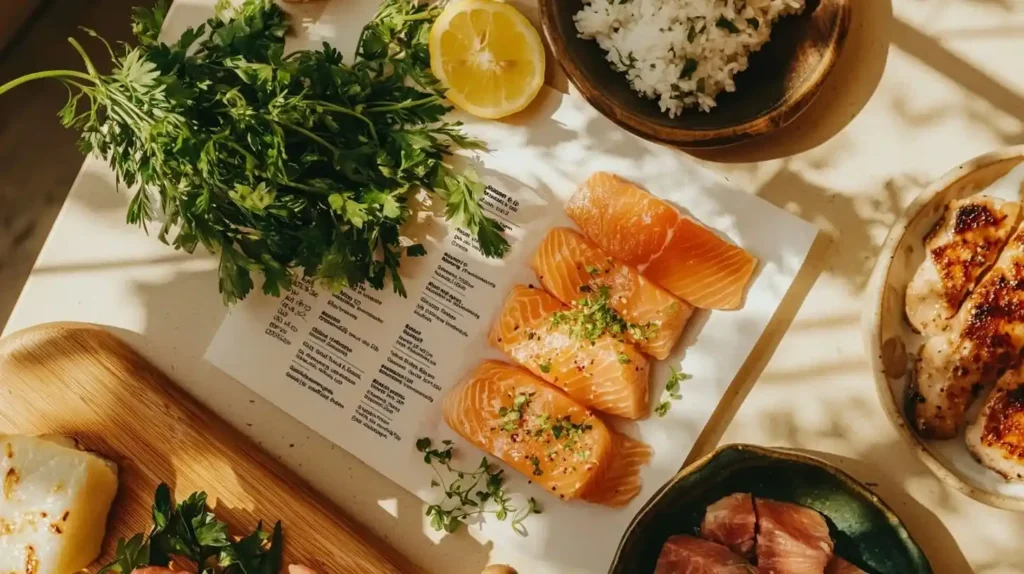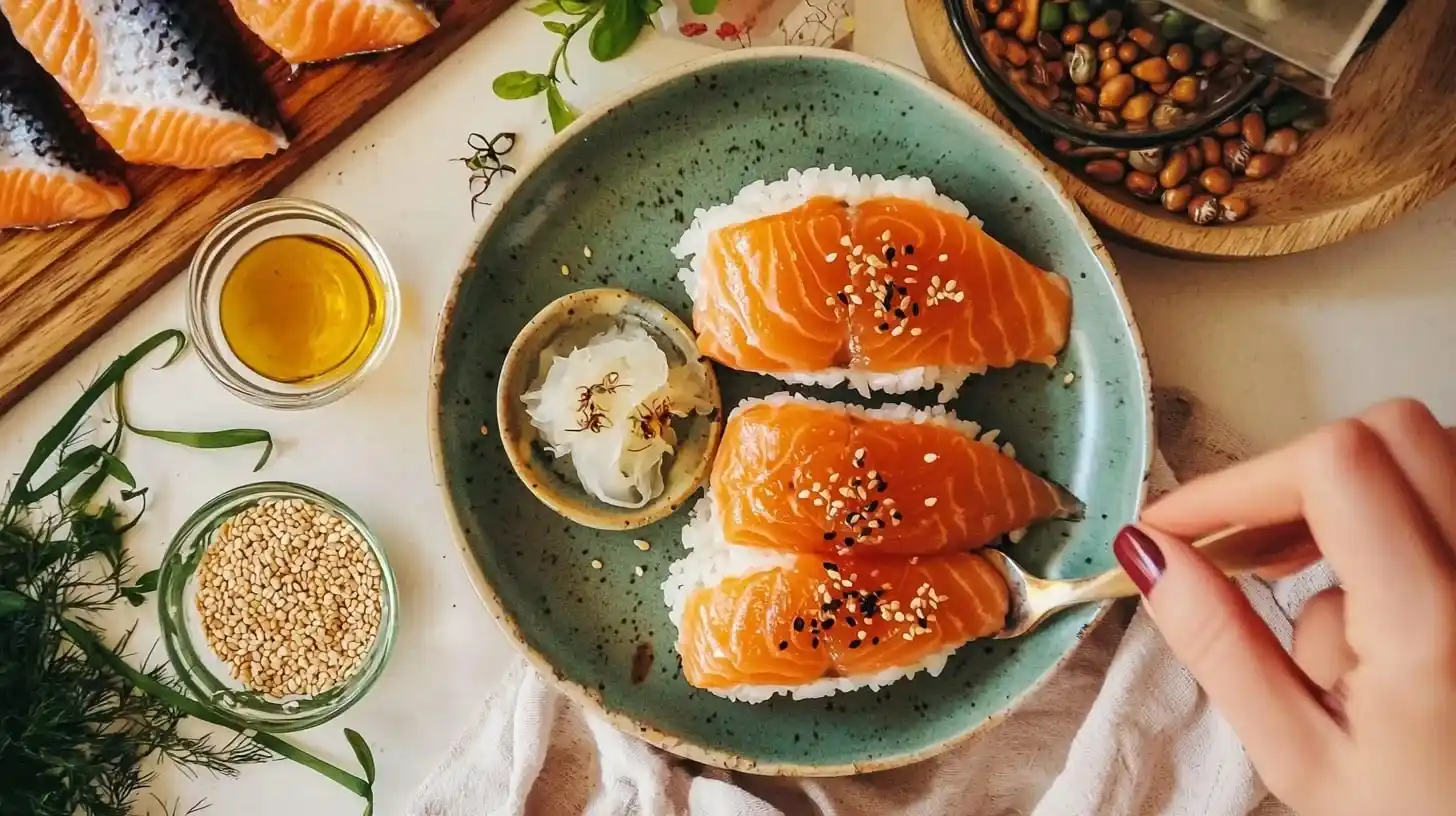“Is this actually good for me?” my husband asked skeptically, eyeing the Salmon Nigiri I’d prepared for our family dinner. His question reflected a common uncertainty many have about Japanese cuisine – particularly dishes featuring raw fish.Is Salmon Nigiri Healthy for You? .
The nutritional profile of salmon nigiri might surprise many who view it merely as an occasional indulgence. This Japanese classic combines nutrient-dense fish with seasoned rice, creating a balanced bite that offers several health benefits when consumed as part of a varied diet.
My family’s journey into Japanese cooking led me to research the nutritional aspects of our favorite dishes, discovering that salmon nigiri offers a particularly favorable combination of macronutrients, healthy fats, and essential vitamins.
Table of Contents
Is Salmon Nigiri Healthy for You? Nutritional Breakdown of Salmon Nigiri

Is Salmon Nigiri Healthy for You? Show Main Image Salmon nigiri offers a nutritional powerhouse in each bite – delivering high-quality protein, essential omega-3s, and important vitamins in a delicious package!
A typical piece of salmon nigiri (approximately 1 oz/28g) contains:
Calories: 40-50 calories Protein: 3-4 grams Carbohydrates: 6-7 grams Fat: 1-2 grams (primarily healthy omega-3 fatty acids) Sodium: 50-100mg (varies with soy sauce use)
This compact nutritional profile delivers significant nutritional value in just a few bites.
For those curious about the distinction between different Japanese fish preparations, What is nigiri vs sashimi? explains that sashimi (fish without rice) offers higher protein and lower carbohydrates than nigiri.
For more globally-inspired nutritious recipes, explore our International Lunch Inspirations: Global Flavors Made Simple collection, which features accessible international dishes for family meals.
Health Benefits of the Key Ingredients
Is Salmon Nigiri Healthy for You? Show Nutritional Comparison Image By the numbers: Salmon nigiri compares favorably to other protein sources, particularly in omega-3 fatty acids and vitamin D content!
Salmon provides several standout nutritional benefits:
High-quality protein: Essential for muscle maintenance, immune function, and cellular repair. My active teenage son appreciates that each piece contributes to his protein needs without heavy preparation.
Omega-3 fatty acids: Specifically EPA and DHA, which support heart and brain health. My grandmother’s cardiologist actually recommended moderate sushi consumption for these beneficial fats.
Vitamin D: A nutrient many Americans lack, supporting bone health and immune function. When I learned salmon is one of the few natural food sources of vitamin D, I began incorporating it more regularly into our meals.
Vitamin B12: Essential for nerve function and blood cell formation. This vitamin is particularly abundant in fish, making salmon nigiri a good source.
The rice component provides:
Energy-providing carbohydrates: The small portion of rice delivers quick energy without overwhelming carbohydrate content.
Small amounts of minerals: Including manganese and selenium from the rice.
For those wondering about preparation, Is salmon nigiri raw? explains that traditional nigiri uses raw fish, which preserves heat-sensitive nutrients that might be reduced through cooking.
Potential Nutritional Concerns
While salmon nigiri offers many benefits, several considerations warrant attention:
Sodium content: Particularly when dipped in soy sauce. My family uses reduced-sodium soy sauce and practices light dipping rather than soaking.
Mercury concerns: While salmon is generally lower in mercury than many other fish, pregnant women and young children should consult healthcare providers about consumption frequency.
Parasites or bacteria: Only when improperly prepared. Using properly sourced “sushi-grade” fish significantly reduces these risks, as my fishmonger carefully explained when I began making nigiri at home.
Calorie density: When consumed in large quantities. A typical nigiri serving of 6-8 pieces provides moderate calories, but restaurant “boat” presentations can add up quickly.
My health-conscious sister limits her soy sauce, opts for lower-mercury fish varieties, and maintains moderate portion sizes to address these concerns while enjoying the benefits.
For comprehensive meal ideas that incorporate Japanese elements into balanced family meals, our Family-Friendly Lunch Recipes: Effortless Meals for Busy Parents collection offers additional inspiration.
Salmon Nigiri in a Balanced Diet
Is Salmon Nigiri Healthy for You? Nutritionists generally view salmon nigiri favorably within a varied diet for several reasons:
Macronutrient balance: Provides protein, healthy fats, and carbohydrates in a single bite.
Portion control: The defined size of nigiri pieces naturally limits consumption compared to larger entrées.
Nutrient density: Delivers significant nutritional value for relatively few calories.
My family’s nutritionist recommended incorporating nigiri-style meals into our monthly rotation, noting they provide “nutrition with natural portion control” – particularly beneficial for my husband who struggles with appropriate serving sizes.
For those curious about experiencing this healthy option, What does salmon nigiri taste like? offers insights into the flavor profile that makes this nutritious choice so appealing.
Answers to Your Nutrition Questions
Is salmon nigiri healthier than other sushi types? Generally yes, especially compared to rolls with tempura or mayonnaise-based sauces. The straightforward preparation of nigiri preserves salmon’s nutritional benefits without adding significant calories through sauces or frying.
How often can I include salmon nigiri in a healthy diet? For most healthy adults, enjoying nigiri 1-2 times weekly provides benefits without concerns about mercury or excessive sodium. My family includes it in our meal rotation twice monthly as part of our varied diet.
Does the rice make nigiri unhealthy? The small portion of rice in nigiri provides carbohydrates but in moderate amounts – typically 1-2 tablespoons per piece. This makes it more balanced than rice-heavy rolls or bowls while still providing satisfaction.
Making Healthy Salmon Nigiri at Home
Several approaches can maximize the health benefits of salmon nigiri:
Source high-quality, sustainable salmon specifically labeled for raw consumption. The nutritional profile is only beneficial if the fish is safely prepared.
Control rice portions by using slightly less than restaurant servings if desired. My husband prefers a higher fish-to-rice ratio than traditional preparations.
Limit soy sauce or choose reduced-sodium varieties. A small dish with just a few drops provides flavor without excessive sodium.
Add vegetable garnishes like microgreens or cucumber to increase nutrient diversity. My children enjoy the color and texture these additions provide.
Consider brown rice variations for additional fiber, though traditionalists would note this significantly changes the authentic experience. We reserve this adaptation for casual family meals rather than when sharing Japanese culture with guests.
Salmon nigiri represents a nutritionally balanced choice that delivers significant health benefits in a delicious, portion-controlled format. When prepared with quality ingredients and enjoyed as part of a varied diet, it offers a sensible way to incorporate the benefits of salmon while experiencing traditional Japanese cuisine.Is Salmon Nigiri Healthy for You?.
With warmth, Sophia





